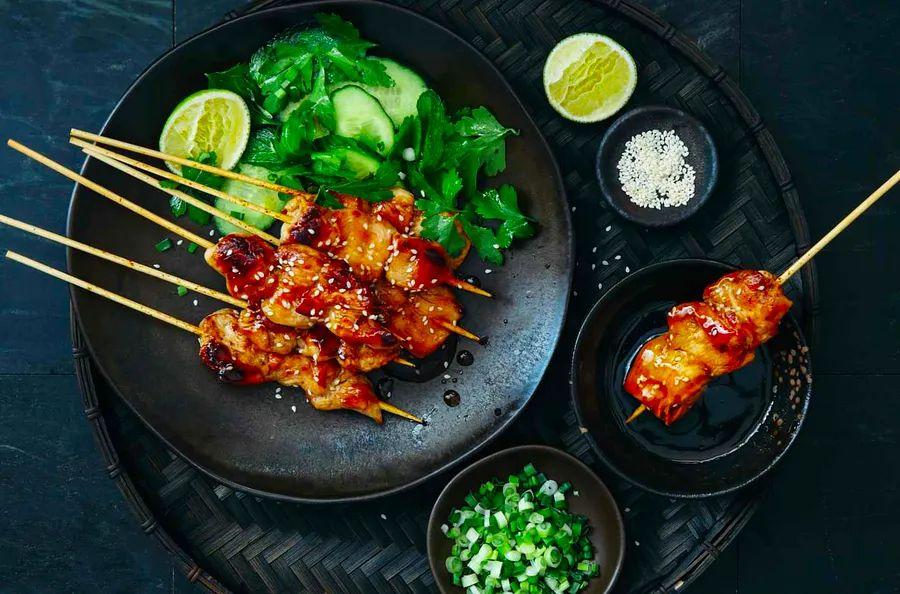What Is Yakitori? Your Essential Introduction to This Classic Japanese Dish

Yakitori, which translates to 'grilled chicken' in Japanese, is made by skewering bite-sized pieces of meat, usually chicken, and grilling them to perfection over an open flame.
In Japan, yakitori is often enjoyed as a street food or casual dish served in izakayas, typically paired with a cold beer or sake. In the U.S., it's gaining popularity in restaurants, with chefs experimenting by using every part of the chicken and even branching out into other meats and ingredients. It's also becoming a fun dinner party trend at home, where grilling skewers together creates a social and interactive dining experience.
Read on to discover what yakitori is, how it’s prepared, and why it could be the highlight of your next dinner party or family meal.
How Is Yakitori Made?
A compact, shallow rectangular grill is at the heart of yakitori preparation. In many restaurants, chefs cook right at the table or at a central grill surrounded by bar-style seating.
Traditional yakitori is cooked over binchotan, a premium Japanese white charcoal. This charcoal burns cleanly, meaning it doesn’t influence the flavor of the meat; the smoky taste comes solely from the grill’s direct heat. If binchotan isn’t available, lump charcoal or briquettes can be used to achieve a similar clean, flavor-neutral result.
The grill maintains a low temperature, around 200°F, ensuring the meat cooks slowly. The chef's job is to rotate the skewers constantly, letting the flames gently kiss the meat. They also keep a careful eye on the moisture level, adjusting it with a special house-made sauce called tare.
Beyond the quality of the ingredients, the signature flavor of yakitori comes from the soy-based tare sauce. Each restaurant has its own unique tare recipe, giving their skewers a distinct flavor. Common tare ingredients include mirin, soy sauce, sake, sugar, scallions, ginger, and various spices.
During grilling, the skewers are briefly dipped in tare, then returned to the grill. Just before serving, they are dipped again or brushed with tare, creating a shiny, lacquer-like coating that's both sweet and savory, but still subtle enough to let the flavor of the chicken shine through.

How to Order at a Yakitori Spot
When you visit an authentic yakitori parlor, you'll likely be seated at the bar around a central grill. If there are tables, they’ll be positioned nearby, so the skewers can be served to diners swiftly.
The menu will feature a variety of chicken cuts to choose from, far beyond just breast or thigh. Options may include chicken heart, cartilage, skin, and even fatty bits. Tsukune, a skewered meatball made from minced chicken mixed with tare and seasonings like shiso or onions, is often available. You may also find a select variety of other meats (like pork belly and beef) and vegetables on the menu.
Once ordered, customers are served one sizzling skewer at a time. They should let it cool briefly before enjoying it right away. In more upscale yakitori spots, condiments like extra tare, a chile-based spice blend, or seasoned salt may be provided. Servers also offer a cup for discarded bamboo skewers.

How Did Yakitori Gain Such Popularity?
Yakitori's rise in the U.S. can be credited to influential food figures like Anthony Bourdain and David Chang. Both featured the dish in their respective TV shows, "No Reservations" and "Ugly Delicious." Bourdain also vividly recounted his yakitori experience in his book Medium Raw, describing the savory drips of chicken fat and the atmosphere of the meal.
Renowned Japanese chefs like Yoshiteru Ikegawa are bringing their expertise to the U.S., attracting upscale diners to this authentic Japanese dish. Meanwhile, popular yakitori chains such as Toritetsu and Tori Jiro are planning to open more affordable locations across the country.
The compact size of a yakitori kitchen and the strong profit margins on ingredients make this dish an appealing choice for chefs and restaurateurs looking to tap into the latest food trends.

How to Host a Yakitori Dinner Party
If you don’t have a yakitori parlor nearby, you can still enjoy the experience of this fun and casual cooking method at home. For your next dinner party, or even just a special night in, host a yakitori-themed gathering. Here’s how to do it.
What You’ll Need:
- Yakitori grill or cast-iron grill pan
- Chimney starter
- Clean-burning charcoal logs
- Bamboo skewers
- Cuts of chicken, beef, pork, and vegetables
For your first yakitori experience, choose two or three yakitori recipes to keep things manageable. Popular choices like Yakitori Chicken, Tsukune (Japanese chicken meatballs), and Beef Yakitori are great starting points. Kawa Yakitori (crispy chicken skin) is a fun addition, too. Don’t forget to prepare a few vegetable skewers to balance out the meal.
Many yakitori recipes require marinating, so make sure to plan ahead and give the proteins enough time to absorb their flavors. Be sure to prepare dipping sauces, like tare, in advance as well.
Invite your friends and family because once the yakitori starts cooking, the pace picks up quickly. Since the skewers cook in just a few minutes, work in batches to keep the yakitori hot and juicy. Let guests grill their own skewers, or take on the role of chef, cooking and serving one round after another.
To recreate the authentic yakitori experience, make sure you have plenty of beer or sake on hand, just like you'd find in a traditional Japanese yakitori bar.
Evaluation :
5/5



